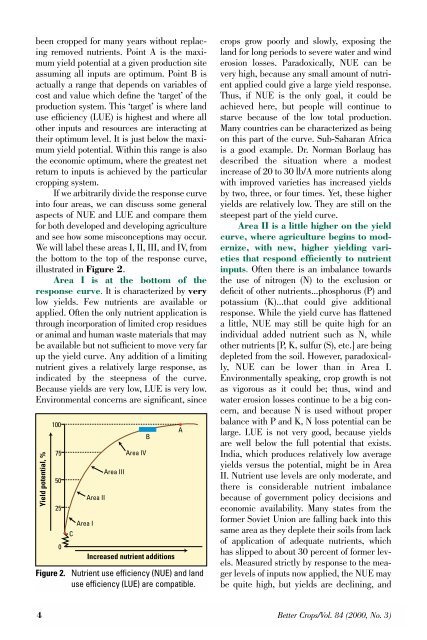The Mysteries (Myths) of Nutrient Use Efficiency
The Mysteries (Myths) of Nutrient Use Efficiency
The Mysteries (Myths) of Nutrient Use Efficiency
Create successful ePaper yourself
Turn your PDF publications into a flip-book with our unique Google optimized e-Paper software.
een cropped for many years without replacing<br />
removed nutrients. Point A is the maximum<br />
yield potential at a given production site<br />
assuming all inputs are optimum. Point B is<br />
actually a range that depends on variables <strong>of</strong><br />
cost and value which define the ‘target’ <strong>of</strong> the<br />
production system. This ‘target’ is where land<br />
use efficiency (LUE) is highest and where all<br />
other inputs and resources are interacting at<br />
their optimum level. It is just below the maximum<br />
yield potential. Within this range is also<br />
the economic optimum, where the greatest net<br />
return to inputs is achieved by the particular<br />
cropping system.<br />
If we arbitrarily divide the response curve<br />
into four areas, we can discuss some general<br />
aspects <strong>of</strong> NUE and LUE and compare them<br />
for both developed and developing agriculture<br />
and see how some misconceptions may occur.<br />
We will label these areas I, II, III, and IV, from<br />
the bottom to the top <strong>of</strong> the response curve,<br />
illustrated in Figure 2.<br />
Area I is at the bottom <strong>of</strong> the<br />
response curve. It is characterized by very<br />
low yields. Few nutrients are available or<br />
applied. Often the only nutrient application is<br />
through incorporation <strong>of</strong> limited crop residues<br />
or animal and human waste materials that may<br />
be available but not sufficient to move very far<br />
up the yield curve. Any addition <strong>of</strong> a limiting<br />
nutrient gives a relatively large response, as<br />
indicated by the steepness <strong>of</strong> the curve.<br />
Because yields are very low, LUE is very low.<br />
Environmental concerns are significant, since<br />
Yield potential, %<br />
100<br />
75<br />
50<br />
25<br />
0<br />
C<br />
Area I<br />
Area II<br />
Area III<br />
Area IV<br />
Increased nutrient additions<br />
Figure 2. <strong>Nutrient</strong> use efficiency (NUE) and land<br />
use efficiency (LUE) are compatible.<br />
B<br />
A<br />
crops grow poorly and slowly, exposing the<br />
land for long periods to severe water and wind<br />
erosion losses. Paradoxically, NUE can be<br />
very high, because any small amount <strong>of</strong> nutrient<br />
applied could give a large yield response.<br />
Thus, if NUE is the only goal, it could be<br />
achieved here, but people will continue to<br />
starve because <strong>of</strong> the low total production.<br />
Many countries can be characterized as being<br />
on this part <strong>of</strong> the curve. Sub-Saharan Africa<br />
is a good example. Dr. Norman Borlaug has<br />
described the situation where a modest<br />
increase <strong>of</strong> 20 to 30 lb/A more nutrients along<br />
with improved varieties has increased yields<br />
by two, three, or four times. Yet, these higher<br />
yields are relatively low. <strong>The</strong>y are still on the<br />
steepest part <strong>of</strong> the yield curve.<br />
Area II is a little higher on the yield<br />
curve, where agriculture begins to modernize,<br />
with new, higher yielding varieties<br />
that respond efficiently to nutrient<br />
inputs. Often there is an imbalance towards<br />
the use <strong>of</strong> nitrogen (N) to the exclusion or<br />
deficit <strong>of</strong> other nutrients...phosphorus (P) and<br />
potassium (K)...that could give additional<br />
response. While the yield curve has flattened<br />
a little, NUE may still be quite high for an<br />
individual added nutrient such as N, while<br />
other nutrients [P, K, sulfur (S), etc.] are being<br />
depleted from the soil. However, paradoxically,<br />
NUE can be lower than in Area I.<br />
Environmentally speaking, crop growth is not<br />
as vigorous as it could be; thus, wind and<br />
water erosion losses continue to be a big concern,<br />
and because N is used without proper<br />
balance with P and K, N loss potential can be<br />
large. LUE is not very good, because yields<br />
are well below the full potential that exists.<br />
India, which produces relatively low average<br />
yields versus the potential, might be in Area<br />
II. <strong>Nutrient</strong> use levels are only moderate, and<br />
there is considerable nutrient imbalance<br />
because <strong>of</strong> government policy decisions and<br />
economic availability. Many states from the<br />
former Soviet Union are falling back into this<br />
same area as they deplete their soils from lack<br />
<strong>of</strong> application <strong>of</strong> adequate nutrients, which<br />
has slipped to about 30 percent <strong>of</strong> former levels.<br />
Measured strictly by response to the meager<br />
levels <strong>of</strong> inputs now applied, the NUE may<br />
be quite high, but yields are declining, and<br />
4 Better Crops/Vol. 84 (2000, No. 3)
















